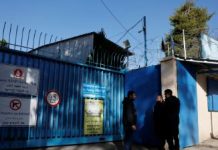By Wu Yuehui, Yu Jianbin, People’s Daily
A Long March-2F Y15 carrier rocket blasted off from the Jiuquan Satellite Launch Center in northwest China at 11:08 p.m. (Beijing Time) on November 29, sending the Shenzhou-15 spaceship and three Chinese astronauts into the space.
It was the last manned mission in the construction phase of China’s space station.
At 7:33 a.m. the next day, the Shenzhou-14 crew opened the hatch of the Tiangong space station in its T-shape configuration, and welcomed the Shenzhou-15 crew. Later, the six astronauts took a group photo together in the space station.
The three Shenzhou-15 crew members are Fei Junlong, Deng Qingming and Zhanglu. The two crews will live together in orbit for around five days.
The first in-orbit rotation in the Chinese space station is challenging. Therefore, the astronauts have made full preparations.
According to experts, during the in-orbit rotation, the two crews will work according to their respective tasks and plans. The Shenzhou-14 crew will make preparations for their return, while the Shenzhou-15 crew will focus more on adapting themselves to the in-orbit environment. The work handover will be completed before the in-orbit rotation ends.
There are two sets of kitchen equipment in orbit, allowing the six to prepare a meal at the same time and share food with each other. In addition, two modules of the space station are equipped with two sanitary areas and six sleeping areas, all of which can be used independently.
The Shenzhou-15 spaceship, the last manned mission launched in the construction phase of China’s space station, is the first one to visit the space station after the T-shape configuration was formed.
The safe arrival of the spaceship marked that the Chinese space station has for the first time expanded to its largest configuration with three modules and three spaceships, having a total mass of nearly 100 tons.
The three modules refer to Tianhe and two lab modules Wentian and Mengtian, and the three spaceships the cargo craft Tianzhou-5 and two spaceships Shenzhou-15 and Shenzhou-14. They demonstrate the remarkable capability of China’s manned space.
It is the first time that two Shenzhou spaceships have docked with the space station simultaneously.
Zhang Yi, designer of the Guidance, Navigation and Control subsystem of Shenzhou spaceships with the China Academy of Space Technology, said that during the rotation, the information of the two manned spaceships will be transmitted through different lines for exclusiveness and accuracy. The space station will offer ventilation and thermal support for the two spaceships. Air supply volume will be distributed according to the thermal environments of the two spaceships. Besides, an emergency evacuation strategy based on the situation of two berthing spaceships has been worked out to ensure the safety of the astronauts.
It is reported that the scientific experiment cabinets carried by the three modules will be comprehensively utilized during the Shenzhou-15 mission. More than 40 experiments and tests in the fields of space science research and application, space medicine and space technology are expected to be carried out.
As space activities are vigorously carried out, the studies on how creatures, including humans, respond to, exist in, change in and adapt to zero-gravity and cosmic radiation conditions, have become an important research subject of space life science.
According to the Chinese Academy of Sciences (CAS), two “mini cubes” supporting life science experiments are taken to the space station by the Shenzhou-15 spaceship.
One of them will be taken to the life and ecology experiment cabinet inside the Wentian space lab to be used for the study and research on space radiation metrology and biological damage assessment technology.
Cai Weiming, a researcher with the CAS Center for Excellence in Molecular Plant Sciences, said the experiment will provide an important basis for in-orbit radiation damage assessment and protection.


















